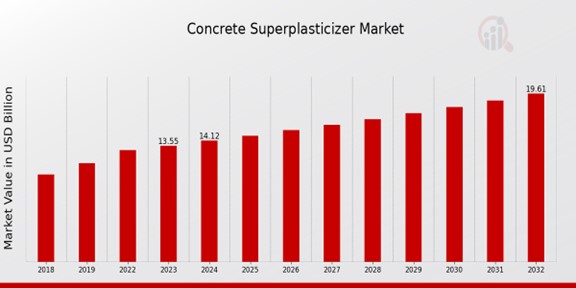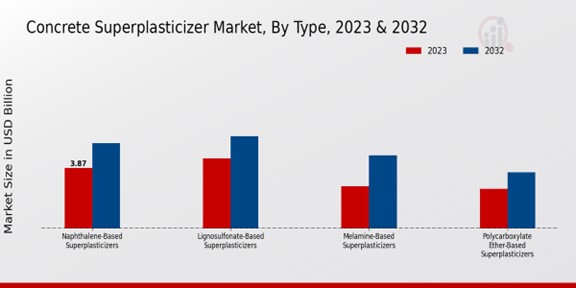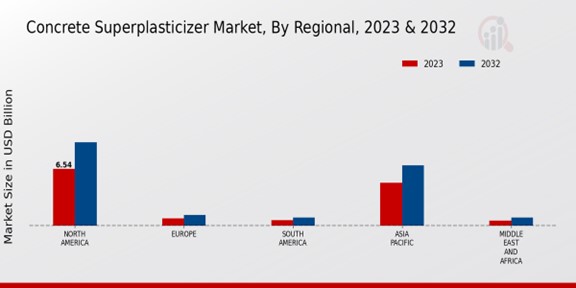Global Concrete Superplasticizer Market Overview
The Concrete Superplasticizer Market Size was estimated at 14.72 (USD Billion) in 2024. The Concrete Superplasticizer Market is expected to grow from 15.33 (USD Billion) in 2025 to 22.19 (USD Billion) by 2034. The Concrete Superplasticizer Market CAGR (growth rate) is expected to be around 4.2% during the forecast period (2025 - 2034).
Key Concrete Superplasticizer Market Trends Highlighted
The concrete superplasticizer market is poised for robust growth, driven by increasing urbanization, infrastructure development, and demand for high-performance concrete.
The construction industry's growing focus on sustainability and environmental regulations is also propelling the demand for eco-friendly superplasticizers.
Several market trends shape the concrete superplasticizer industry. The adoption of advanced technologies, such as nanotechnology and green chemistry, leads to the development of next-generation superplasticizers with improved performance and reduced environmental impact.
Additionally, the growing popularity of precast concrete and self-compacting concrete drives the need for superplasticizers that enhance workability and flowability.
Key market drivers include the increasing demand for high-strength and durable concrete in commercial and residential buildings, the rising adoption of sustainable construction practices, and the growing awareness of the benefits of superplasticizers in reducing construction time and costs.
Opportunities for exploration lie in the development of innovative superplasticizer formulations that cater to specific construction applications and meet environmental regulations.

Source: Primary Research, Secondary Research, MRFR Database and Analyst Review
Concrete Superplasticizer Market Drivers
Rising Demand for High-Strength Concrete
Concrete superplasticizers play a crucial role in the production of high-strength concrete, which is increasingly being used in construction projects worldwide.
High-strength concrete offers superior strength, durability, and resistance to various environmental factors, making it ideal for constructing tall buildings, bridges, and other critical infrastructure.
The growing demand for high-strength concrete in the construction industry is a significant driver for the Concrete Superplasticizer Market.
Increasing Infrastructure Development
The expansion of infrastructure projects across the globe is another key driver for the Concrete Superplasticizer Market.
Governments and private investors are focusing on developing new infrastructure, including roads, bridges, airports, and railways, to support economic growth and improve connectivity.
Concrete superplasticizers are essential in these projects as they enhance the workability and strength of concrete, enabling faster construction and improved durability of infrastructure assets.
Advancements in Construction Techniques
The construction sector is continually changing, and there are new methods or materials to improve construction efficiency and productivity.
The utilization of superplasticizers of concrete is widely adopted in modern construction ways, particularly precast concrete and self-compact concrete.
For these modern methods to be effectuated there is a need for high workable and flowable concrete, and this is achieved using superplasticizers.
The adoption of advanced construction methods is one of the drivers of the Concrete Superplasticizer Market.
Concrete Superplasticizer Market Segment Insights
Concrete Superplasticizer Market Type Insights
The Concrete Superplasticizer Market is segmented by type into Naphthalene-Based Superplasticizers, Lignosulfonate-Based Superplasticizers, Melamine-Based Superplasticizers, and Polycarboxylate Ether-Based Superplasticizers.
Naphthalene-Based Superplasticizers are the most widely used type of superplasticizers, accounting for over 50% of the market share. They are cost-effective and provide good workability to concrete.
However, they have a high-water demand, which can lead to shrinkage and cracking in concrete. Lignosulfonate-Based Superplasticizers are a type of natural superplasticizers that are derived from wood pulp.
They are biodegradable and have a low water demand, making them an environmentally friendly option. However, they are not as effective as Naphthalene-based Superplasticizers in terms of workability.
Melamine-Based Superplasticizers are a type of synthetic superplasticizers that are known for their high water-reducing capacity.
They are used in concrete applications where high strength and durability are required. However, they are more expensive than other types of superplasticizers. Polycarboxylate Ether-Based Superplasticizers are the latest type of superplasticizers that have been developed.
They have a high water-reducing capacity and provide excellent workability to concrete. They are also more durable than other types of superplasticizers. The growth of the market is attributed to the increasing demand for concrete in the construction industry.
The growing awareness of the benefits of superplasticizers, such as improved workability, reduced water demand, and increased strength, is also driving the growth of the market.

Source: Primary Research, Secondary Research, MRFR Database and Analyst Review
Concrete Superplasticizer Market Application Insights
The Concrete Superplasticizer Market based on application is divided into Ready-Mix Concrete, Pre-cast Concrete, Shotcrete, Structural Concrete, and High-Performance Concrete.
Ready-Mix Concrete dominated the market in 2023, and this segment is expected to hold the largest market share over the forecast period as well.
The growth of this segment is driven by the uptick in the demand for ready-mix concrete in the construction of buildings.
It is favored by the end users because it is cost-efficient, convenient, and consistent. Pre-cast Concrete is another prominent segment, and it is projected to exhibit constant growth over the forecast period.
There is an increase in the uptake of precast concrete components in the construction of residential and commercial buildings because of their long useful life and excellent heat resistance and dimensional accuracy.
Shotcrete, Structural Concrete, and High-Performance Concrete are other significant segments in the market.
The Concrete Superplasticizer Market is expected to continue its growth, and the factor that drives it is the increased demand for concrete in the building of commercial and residential buildings across the globe.
Concrete Superplasticizer Market Construction Type Insights
The construction type segment of the Concrete Superplasticizer Market is categorized into residential construction, commercial construction, infrastructure construction, and industrial construction.
Among these, residential construction held the largest market share in 2023, owing to the increasing demand for new residential buildings and the renovation of existing ones.
Commercial construction is expected to witness significant growth in the coming years due to the rising number of commercial projects such as offices, retail stores, and hotels.
Infrastructure construction is also anticipated to drive market growth as governments worldwide invest in the development and maintenance of roads, bridges, and other infrastructure projects.
Industrial construction is expected to contribute to market growth due to the increasing demand for warehouses, factories, and other industrial facilities.
Concrete Superplasticizer Market End User Insights
The 'End User' segment of the Concrete Superplasticizer Market holds significant importance, accounting for a substantial share of the overall market revenue.
Key end users in this segment include concrete contractors, construction companies, precast concrete producers, and infrastructure developers.
The growth of the construction industry, particularly in emerging economies, is a significant driver for the increasing demand for concrete superplasticizers.
These end users leverage concrete superplasticizers to enhance the workability and durability of concrete, leading to improved construction efficiency and cost savings.
As per industry data, the concrete superplasticizer market is projected to reach a valuation of approximately 16.5 billion USD by 2024, indicating a steady market growth in the coming years.
Concrete Superplasticizer Market Regional Insights
The Concrete Superplasticizer Market is segmented into North America, Europe, APAC, South America, and MEA. The North American region is expected to dominate the market due to the high demand for concrete superplasticizers in the construction industry.
The European region is also expected to witness a significant growth in the market owing to the increasing adoption of sustainable construction practices.
The APAC region is anticipated to be the fastest-growing market due to the rapid urbanization and industrial development in the region.
South America and MEA are expected to witness a steady growth in the market due to the increasing investments in infrastructure development.

Source: Primary Research, Secondary Research, MRFR Database and Analyst Review
Concrete Superplasticizer Market Key Players and Competitive Insights
Major players in the Concrete Superplasticizer Market are always looking for ways to improve their market position. They are investing in research and development to come up with new and innovative products. They are also expanding their distribution networks to reach new customers.
The Concrete Superplasticizer Market is expected to witness healthy growth in the coming years. The rising demand for concrete in the construction industry is expected to drive the growth of the Concrete Superplasticizer Market.
Leading Concrete Superplasticizer Market players are focusing on developing sustainable and eco-friendly products.
They are also working on reducing the cost of production. The Concrete Superplasticizer Market Competitive Landscape is expected to remain competitive in the coming years.
BASF is a leading Concrete Superplasticizer Market player. The company offers a wide range of concrete superplasticizers under the Glenium brand. BASF's concrete superplasticizers are used in a variety of applications, including the construction of bridges, tunnels, and buildings.
The company has a strong presence and is constantly expanding its distribution network. BASF is committed to research and development and is constantly investing in new technologies. The company is also focused on sustainability and is working on developing eco-friendly products.
Sika is another leading Concrete Superplasticizer Market player. The company offers a wide range of concrete superplasticizers under the Sika ViscoCrete brand. Sika's concrete superplasticizers are used in a variety of applications, including the construction of bridges, tunnels, and buildings.
The company has a strong presence and is constantly expanding its distribution network. Sika is committed to research and development and is constantly investing in new technologies. The company is also focused on sustainability and is working on developing eco-friendly products.
Key Companies in the Concrete Superplasticizer Market Include
- Ashland Holdings
- GCP Applied Technologies
- Euclid Chemical
- RPM International
- Arkema
- Sika
- Mapei
- Dow Chemical
- BASF
- R. Grace
- Evonik Industries
- Fosroc
- Solvay
- HB Fuller
- Chryso
Concrete Superplasticizer Market Developments
Increasing demand for high-performance concrete in construction projects, coupled with growing infrastructure development across emerging economies, is primarily driving market growth.
The rising adoption of green building practices and the need for sustainable construction materials are further contributing to the market's expansion.
Recent news developments include the launch of innovative superplasticizers with enhanced workability, durability, and sustainability characteristics.
Key players are focusing on strategic partnerships and acquisitions to expand their product portfolios and geographical reach.
Moreover, government regulations and industry initiatives aimed at promoting sustainable construction practices are expected to provide further impetus to the market.
Concrete Superplasticizer Market Segmentation Insights
Concrete Superplasticizer Market Type Outlook
- Naphthalene-Based Superplasticizers
- Lignosulfonate-Based Superplasticizers
- Melamine-Based Superplasticizers
- Polycarboxylate Ether-Based Superplasticizers
Concrete Superplasticizer Market Application Outlook
- Ready-Mix Concrete
- Precast Concrete
- Shotcrete
- Structural Concrete
- High-Performance Concrete
Concrete Superplasticizer Market Construction Type Outlook
- Residential Construction
- Commercial Construction
- Infrastructure Construction
- Industrial Construction
Concrete Superplasticizer Market End User Outlook
- Concrete Contractors
- Construction Companies
- Precast Concrete Producers
- Infrastructure Developers
Concrete Superplasticizer Market Regional Outlook
- North America
- Europe
- South America
- Asia-Pacific
- Middle East and Africa
| Report Attribute/Metric |
Details |
| Market Size 2024 |
14.72 (USD Billion) |
| Market Size 2025 |
15.33 (USD Billion) |
| Market Size 2034 |
22.19 (USD Billion) |
| Compound Annual Growth Rate (CAGR) |
4.2% (2025 - 2034) |
| Report Coverage |
Revenue Forecast, Competitive Landscape, Growth Factors, and Trends |
| Base Year |
2024 |
| Market Forecast Period |
2025 - 2034 |
| Historical Data |
2020 - 2024 |
| Market Forecast Units |
USD Billion |
| Key Companies Profiled |
Ashland Holdings, GCP Applied Technologies, Euclid Chemical, RPM International, Arkema, Sika, Mapei, Dow Chemical, BASF, W.R. Grace, Evonik Industries, Fosroc, Solvay, HB Fuller, Chryso |
| Segments Covered |
Type, Application, Construction Type, End User, Regional |
| Key Market Opportunities |
Growing infrastructural investments Increasing awareness of sustainable construction Rising demand for high-performance concrete Expanding applications in various industries and technological advancements |
| Key Market Dynamics |
Rising infrastructure development, growing demand for durable concrete, technological advancements, increasing environmental concerns, and expanding construction sector |
| Countries Covered |
North America, Europe, APAC, South America, MEA |
Frequently Asked Questions (FAQ) :
The concrete superplasticizer market is expected to reach USD 22.19 billion by 2034, exhibiting a CAGR of 4.2% during the forecast period (2025-2034).
Asia-Pacific is expected to dominate the concrete superplasticizer market throughout the forecast period. The region's high demand for concrete superplasticizers is primarily driven by the rapid growth of the construction industry in countries like China, India, and South Korea.
Concrete superplasticizers are primarily used in the production of concrete for various applications, including residential and commercial buildings, bridges, roads, and other infrastructure projects. They enhance the workability, strength, and durability of concrete.
Some of the prominent players in the concrete superplasticizer market include BASF, Sika AG, GCP Applied Technologies, W.R. Grace & Co., and Fosroc.
The increasing demand for high-performance concrete, the growing construction industry, and the rising need for durable and sustainable infrastructure are the primary growth drivers for the concrete superplasticizer market.
The concrete superplasticizer market faces challenges such as fluctuating raw material prices, stringent environmental regulations, and competition from alternative plasticizers.
The concrete superplasticizer market is anticipated to register a CAGR of 4.2% from 2025 to 2034, reaching a value of USD 22.19 billion by 2034.
The commercial construction segment is projected to grow at the highest CAGR during the forecast period, driven by the increasing demand for high-rise buildings, shopping malls, and other commercial structures.
The COVID-19 pandemic had a moderate impact on the concrete superplasticizer market, causing temporary disruptions in construction activities. However, the market is expected to rebound as construction projects resume and infrastructure development gain momentum.
Key trends in the market include the development of sustainable and eco-friendly superplasticizers, the adoption of advanced technologies for concrete production, and the growing demand for high-performance concrete in precast and pre-stressed applications.

















